- Home
- Max Brooks
The Zombie Survival Guide: Complete Protection From the Living Dead Page 7
The Zombie Survival Guide: Complete Protection From the Living Dead Read online
Page 7
7. TIGHT CLOTHES AND SHORT HAIR
Cold, hard figures have shown that when battling the living dead, nothing has saved more victims than basic, tight clothing and closely cropped hair. The simple fact is that ghouls attack by reaching out to grab their victims, pulling them in, then biting. Logic dictates that the less material a person offers up for grabs, the better his or her chances will be. Baggy clothing, complete with pockets, straps, or anything that might hang freely, will be a convenient handle for grasping zombie claws. Anyone who has worked in factories or with some kind of heavy machinery will tell you the importance of never letting anything hang loose. Tight clothing, obviously within comfort limits, will help to eliminate this danger. Hair can be a similar hazard. Many times, victims have been seized and even dragged by their hair to a gruesome end. Tying one’s hair back before a conflict may work temporarily. However, a short haircut, one inch or shorter, is ideal for hand-to-hand combat.
ON THE DEFENSE
The story of Yahya Bey, a Turkish immigrant to the United Kingdom, describes an attack on his home village of Oltu. According to Bey, a swarm of zombies descended from the surrounding hills in the dead of night. Those who were not devoured fled either to their homes, the town mosque, or the local police station. Several were crushed in the panic to enter this last location while an accidental fire killed everyone inside. Many people, lacking the time and materials to barricade all their doors and windows, were overrun by the undead. Many, suffering from bites, sought shelter in the home of the town doctor. As he attempted to treat his patients, they expired, then reanimated. Bey, a six-year-old boy, managed to climb onto the roof of his house, remained there for most of the night, then took off at first light, jumping from roof to roof until he reached open ground. Although no one in the nearby villages believed his story, a search party was sent to look for human marauders. This group found Oltu in shambles, all buildings burned, smashed, or otherwise destroyed. Half-eaten corpses littered the deserted streets. Dragging footprints, enough to suggest a sizable group, followed a track of fewer, faster tracks into the mountains. Neither group was ever discovered.
What is the perfect protection from the undead? Truthfully, there isn’t one. Defense isn’t as simple as physical safety. Supposing you manage to find, build, or modify a structure to keep the external threats at bay—then what? Zombies will not just go away, and there’s no telling how long it will take for rescue. How will you survive? Hunger, thirst, disease, and many other factors have claimed as many lives as the walking dead. Siege warfare, the type our ancestors faced when their castles or villages were surrounded by enemies, is what you will be facing when the dead walk again. Physical safety is only one part of the equation. To be fully prepared, you must have a working knowledge of stationary survival. In an interdependent world, this art has long since been forgotten. Look around your home. How many items have been manufactured within ten, fifty, even a hundred miles of it? Our way of life, particularly as members of the richest industrialized nation on earth, requires a delicate network of transportation and communication to exist. Remove that network, and we are reduced to a standard of living reminiscent of medieval Europe. Those who comprehend this and plan for such an existence stand a much greater chance of survival. This section shows both how to create a stronghold and how to live within its boundaries.
THE PRIVATE RESIDENCE (DEFENDING YOUR HOME)
For Class 1 conflicts, most people’s homes will provide adequate shelter. There is no need to flee the city or town as soon as you hear that the dead are walking. In fact, this is highly discouraged. In the first hours of a zombie attack, most of the population will try desperately to escape. Roads will become a mass of stationary vehicles and panicked people, a situation that is rife with the potential for violence. Until the living destroy the dead, or the dead overrun the living, trying to flee would only add more bodies to the anarchy. So load your weapons, prepare for a fight, but stay put, stay safe, stay alert. And what better place to do so than in the comfort of your own home?
1. PREPARATION PART I: THE HOME
Before the dead rise, before the chaos and carnage begin, certain homeowners will find that they are safer than their neighbors. Although no house was ever constructed for the purpose of zombie defense, several designs have proved remarkably secure. If your house itself is not structurally ready for a zombie attack, various measures can be employed to fortify it.
A. Exceptions
Stilted homes, as seen on beaches and along rivers and other high watermark areas, were built mainly to avoid being overrun by floods. Their height already makes conventional attacks impossible. Doors and windows could even remain open and unboarded. The only entrance and one or two outside staircases could either be barricaded or destroyed once the alarm is sounded. Secure on this raised platform, survival time would be determined only by the amount of provisions a homeowner had stockpiled.
There is another highly protective dwelling that was built to combat a force just as prevalent, and just as deadly, as an undead army: Tornado-proof “safe houses,” now being constructed in the American heartland, are designed to resist mild to moderate twisters. Their layout consists of concrete walls, steel-reinforced doors, and steel shutters neatly concealed behind everyday curtains. On their own, these domiciles could withstand both a Class 1 and Class 2 outbreak.
B. Modifications to Houses
Securing a house against the undead is similar to securing it from the living. One difference is the common burglar alarm. Many of us sleep securely at night only because our alarms are “armed” and working. But what do these devices really do, other than send a signal to a private security or police force? What if these forces don’t come? What if they are occupied with other battles? What if they are ordered to protect areas deemed “more important”? What if they have ceased to exist, disappeared into the stomachs of ghouls? In any of these cases, direct means of defense are called for.
Security bars on doors and windows will stop a group of zombies for a limited amount of time. Experience has shown that as few as three walking dead can tear them down in less than twenty-four hours.
Tempered safety glass prevents entry by smashing but can be forced right out of its pane. This can easily be fixed by installing concrete or steel frames. However, the money it would take to replace each window in an average house could and should be spent instead on purchasing or building one of the two house types discussed above: stilted or tornado-proof domiciles.
A good ten-foot chain-link fence can hold dozens of zombies for weeks, even months, provided their numbers remain at Class 1. A ten-foot cinder-block wall, reinforced with steel rods and filled with concrete, is the safest barrier in both Class 1 and Class 2 outbreaks. Zoning laws may prohibit a wall this high, but don’t dismiss it. (Check with your local zoning board.) Although zombies have been known (on rare occasions) to hoist themselves over obstacles as high as six feet, this has never occurred en masse. Several people, well-armed and with good communication, can maintain a six-foot wall, not easily but safely, for as long as the stamina of this group holds out.
A gate should be steel or wrought-iron, solid if possible. It should slide to one side, not swing in or out. Reinforcement is as simple as parking your car up against it. Electric motors make opening easier but will leave you trapped in a power outage or breakdown.
As stated earlier, a ten-foot concrete wall will only provide adequate protection in a Class 1 or Class 2 outbreak. In a Class 3 outbreak, enough zombies can, and will, climb on top of each other until they form an undead ramp right over your wall.
C. Apartments
Apartments and apartment buildings vary in size and layout and, therefore, in defensibility. However, from the squat two-story buildings of Los Angeles to the concrete and glass towers of New York, certain basic rules apply.
First-floor apartments present the highest risk simply because of their accessibility. Tenants living above the ground floor are almost always safer than
those in any type of house. Destroying the staircase effectively isolates the rest of the building. With the elevator turned off and the fire escape too high for a zombie to reach (strict limits are imposed by law), any apartment house can become an instant haven from the walking dead.
Another advantage of the apartment complex is its large population. Whereas a private homeowner may be forced to hold the residence by himself, an apartment building can be defended by all of its tenants. This also increases the chances of having multiple skilled experts such as carpenters, electricians, paramedics, and Army reservists (not always the case, but still a possibility). Of course, with additional people comes the challenge of additional social conflicts. This potential problem, however, should never be a deterrent when choosing between a house and an apartment. Given the choice, always pick the latter.
IMPORTANT NOTE: DISCOUNT HOME-DEFENSE MANUALS!
Although almost every other section in this book encourages the use of conventional texts (on weapons use, military tactics, survival skills, and so on), those written to protect a domicile are not recommended. Home-defense books are designed to counter a human adversary with human skills and human intelligence. Many of the tactics and strategies featured in these books, such as employing elaborate alarm systems, booby traps, and painful, but nonlethal devices such as Mace canisters or nail heads in the carpet, would be useless against an undead intruder.
2. PREPARATION PART II: SUPPLIES
Once the private residence is secure, stockpiling for a siege must be undertaken. There is no telling how long it will take for help to arrive. There is no telling if help ever will. Always be prepared for a long siege. Never assume a quick rescue.
A. Weapons
Whereas in the field you must travel light to maintain mobility, in your home you have the luxury of storing and maintaining a plethora of weapons. This does not mean filling your home with any capricious instrument of destruction. Each home arsenal should include:
•
Rifle, 500 rounds
•
Shotgun, twelve-gauge, 250 shells
•
Pistol, .45 caliber, 250 rounds
•
Silencer (rifle)
•
Silencer (pistol)
•
Heavy crossbow (in lieu of silencers), 150 bolts
•
Telescopic sight (rifle)
•
Night-vision scope (rifle)
•
Laser sight (rifle)
•
Laser sight (pistol)
•
Katana sword
•
Wakizashi or other short-bladed sword
•
Two knives with smooth, six- to eight-inch blades
•
Hand hatchet
(NOTE: This list applies to a single individual. Numbers should be adjusted depending on the number of people in the group.)
B. Equipment
Now that all weapons have been chosen, consider what equipment is necessary for your maintenance and perhaps even survival. In the short run, standard disaster-survival kits will suffice. Any longer, and the material below will be necessary. Common household items such as clothing, toilet paper, etc., are assumed to be kept on hand in reasonable quantities.
•
Water, three quarts per day, for cooking and washing
•
Hand-pumped water filter
•
Four replacement filters
•
Cistern for collecting rainwater
•
Iodine and/or purification tablets
•
Canned food, three cans per day (preferable to dried goods in that they contain some water)
•
Two portable electric stoves
•
Advanced medical kit (must include field-surgery implements and antibiotics)
•
Bicycle-powered electric generator
•
Gasoline generator (to be used only in emergencies)
•
Twenty gallons of gasoline
•
Rechargeable, battery-powered shortwave radio
•
Two battery-powered flashlights
•
Two rechargeable, battery-powered electric lamps
•
Two rechargeable, battery-powered and/or solar-powered radios
•
Appropriate reinforcement materials, including lumber, bricks, mortar, etc.
•
Extensive tool kit, including sledgehammer, ax, handsaw, etc.
•
Lime and/or bleaching powder in sufficient supply to maintain latrine
•
One high-powered telescope (80X–100X), with spare lenses and cleaning equipment
•
Fifteen emergency flares
•
Thirty-five chemical light sticks
•
Five fire extinguishers
•
Two sets of earplugs
•
Spare parts for all aforementioned machinery and user’s manuals
•
Extensive library of manuals, including a general disaster manual
(NOTE: As with weapons, personal items such as food, water, and medicine must be multiplied for the number of people in your group.)
3. SURVIVING AN ATTACK
The siege has commenced. Zombies swarm around your home, incessantly attacking but unable to enter. At this point, your worries are far from over. Waiting out a siege does not mean sitting idle. Many tasks will have to be accomplished and repeated for survival in a confined space.
A.
Designate one corner of your backyard to serve as a latrine. Most survival manuals will explain the finer points of construction and disposal.
B.
If soil and rain permits, dig a vegetable garden. This ready source of food should be consumed first, saving the canned food for an emergency. Keep it as far away from the latrines as possible, to avoid infection not by waste but by the residual effects that lime or bleach will have on the soil.
C.
For electricity, always resort to the manual (bicycle-powered) generator. Not only is the gasoline model loud and potentially dangerous—its fuel is finite. Use it only in extreme circumstances, such as a night attack, when manual power is unfeasible or impossible to generate.
D.
Patrol the wall constantly. If you’re in a group, run patrols on a twenty-four-hour basis. Always be vigilant for an unlikely but possible infiltration. If you are alone, limit your patrols to daylight hours. At night, make sure all doors are secure (windows should already be barred). Sleep with a flashlight and weapon nearby. Sleep lightly.
E.
Maintain a low profile. If you have a basement, do your cooking there, along with power generation and any equipment maintenance. When you monitor the radio, something that should be done every day, use headphones. Keep blackout curtains on all windows, especially at night.
F.
Dispose of all bodies. Be it zombie or human, a corpse is still a corpse. The bacteria in rotting flesh can be a serious health hazard. All bodies within your perimeter should be burned or buried. All bodies outside of your wall should be burned. To do this, simply stand on a ladder on your side of the wall, pour gasoline on the freshly slain ghoul, light a match and let it fall. Although this may attract more undead to your dwelling, it is a necessary risk to remove an already-present hazard.
G.
Exercise daily. Use of the stationary bicycle, along with basic calisthenics and dynamic tension, will keep your body fit and strong enough for any combat situation. Again, make sure your regimen is quiet. If a basement is not available, use a room in the center of the house. Basic soundproofing such as mattresses and blankets against the walls will help to muffle any sounds.
H.
Remain entertained. Despite the need for vigilance, recreation is a must. Make sure a large cache of books, games, and other forms of amusement are available (electronic games are too noisy and energy-inefficient to be considered). In a long and seemingly interminable siege, boredom can lead to paranoia, delusion, and hopelessness. It is as important to keep your mind in good shape as it is your body.
I.
Keep your earplugs handy, and use them often. The constant, collective moan of the undead, a sound that will persist at all hours for as long as the siege continues, can be a deadly form of psychological warfare. People with well-protected, well-supplied homes have been known to either kill one another or go insane simply from the incessant moan.

 World War Z: An Oral History of the Zombie War
World War Z: An Oral History of the Zombie War Minecraft: The Island
Minecraft: The Island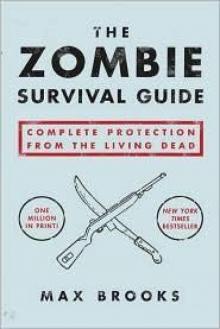 The Zombie Survival Guide: Complete Protection From the Living Dead
The Zombie Survival Guide: Complete Protection From the Living Dead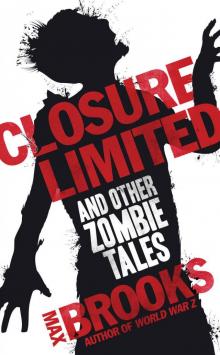 Closure, Limited and Other Zombie Stories
Closure, Limited and Other Zombie Stories Devolution: A Firsthand Account of the Rainier Sasquatch Massacre
Devolution: A Firsthand Account of the Rainier Sasquatch Massacre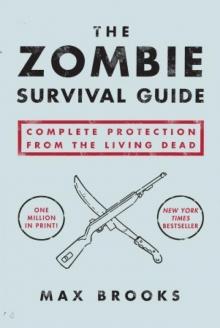 The Zombie Survival Guide
The Zombie Survival Guide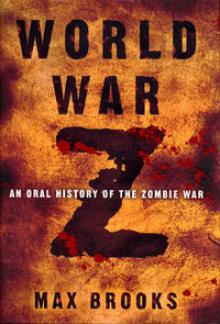 World War Z
World War Z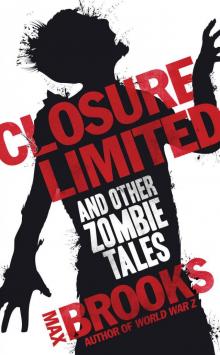 Closure, Limited
Closure, Limited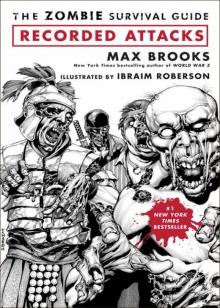 The Zombie Survival Guide: Recorded Attacks
The Zombie Survival Guide: Recorded Attacks World War Z_An Oral History of the Zombie War
World War Z_An Oral History of the Zombie War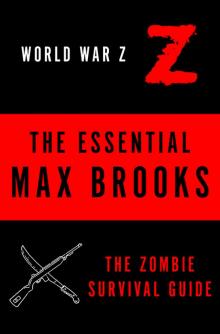 The Essential Max Brooks: The Zombie Survival Guide and World War Z
The Essential Max Brooks: The Zombie Survival Guide and World War Z